 Wearing Sadakichi’s Hat
Wearing Sadakichi’s Hat
Last week I finally got to do something I’ve planned for years: have some pictures made of myself wearing Sadakichi Hartmann’s hat.
That calls for some explanation.
Scion of a German father and a Japanese mother, Sadakichi Hartmann (1867-1944) was born on an island in Nagasaki harbor. His mother died in childbirth, and he and his older brother were taken to Hamburg, Germany, and raised in luxury. By the age of 9 he’d reportedly read all of Goethe and Schiller. At the age of 13 he was placed in military school but rebelled against the discipline there and ran away to Paris. His angry father shipped him off to America to live with an uncle here. He arrived in 1882, found work in printing and engraving shops, and educated himself by reading at night in Philadelphia’s excellent free Mercantile Library.
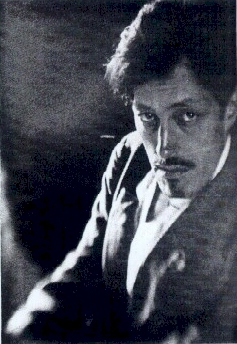
Charles Fournier, portrait of Sadakichi Hartmann (1917)
Drawn to the arts, Hartmann befriended Walt Whitman, for whom he did occasional translation of German correspondence. He recorded his visits to the aged poet in Conversations with Walt Whitman (1895). He made his way to Europe and the U.K. four times to further his knowledge of theater, literature, and visual art, managing to meet Algernon Charles Swinburne, the Rossettis (Dante Gabriel and his sister Christina), Stéphane Mallarmé, and Franz Liszt, among other notables. (He corresponded with Mallarmé through 1897.)
Hartmann began his work as an art critic for Philadelphia newspapers in the 1880s, and subsidized his travel to Europe in 1891 by going as a foreign correspondent for the McClure Syndicate, as a result of which he interviewed many of the major creative artists and writers of the time. His first commentaries on photography came circa 1893, his last around 1920. During that period, in addition to writing extensively about the medium for a wide range of periodicals, he lectured widely on the subject and juried countless exhibitions of photography across the U.S.
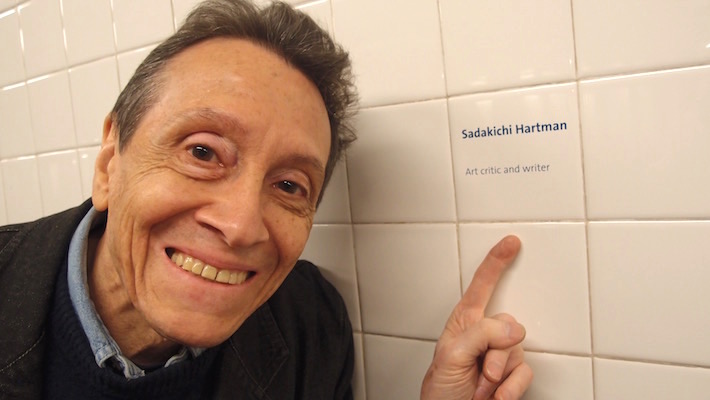
ADC with Sadakichi Hartmann’s hat, New York, May 15, 2015 (b). Photo © 2015 by Anna Lung.
In 1892 he became a staff writer for a Boston publication, and in 1893 founded a short-lived avant-garde art magazine, The Art Critic, which lasted a mere four issues. He then relocated to New York and strode through the streets of Greenwich Village with long, flowing dark hair, wearing a cape — a flamboyant figure, the self-styled “king of Bohemia” (though he called himself “a bread-and-butter writer” because he wrote for a living). He had many talents, many of them not fully realized during his lifetime. Edward Weston, who saw him perform at a party when Hartmann was in his sixties, once described him as the finest interpretive male dancer he’d ever seen, an opinion shared by many.
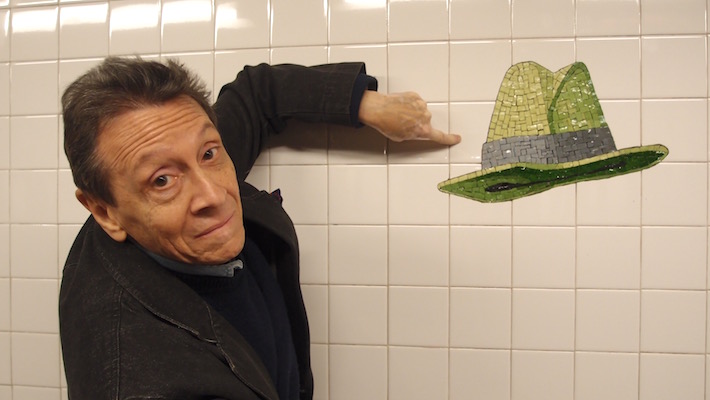
ADC with Sadakichi Hartmann’s hat, New York, May 15, 2015 (d). Photo © 2015 by Anna Lung.
A poet, playwright, author of short fiction, and graphic artist, as well as a critic of art and photography, Hartmann also published under various pseudonyms, the most frequent of which was Sidney Allan. He began to engage with photography at the moment when Alfred Stieglitz and others commenced their push for its recognition as an art form. Along with Charles Caffin, he became something of a “house critic” for Camera Notes during Stieglitz’s editorship thereof and then for Camera Work, the journal founded by Stieglitz in the early years of the twentieth century.
Hartmann published well over 600 essays on photography during the course of his career, making him unquestionably the most prolific critic of the medium up until that point and for half a century thereafter. According to Harry W. Lawton and George Knox, “He was admired; he was feared; he was detested. Among the pioneers of photographic criticism in America none exerted such direct personal influence on so many photographers” as did Hartmann.
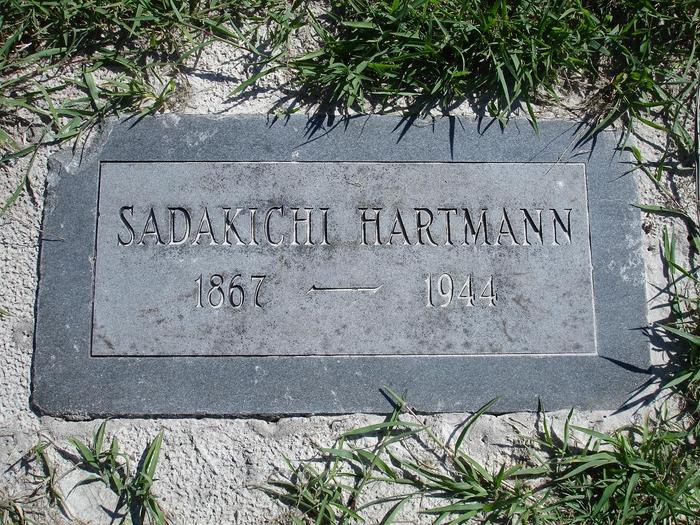
Sadakichi Hartmann’s headstone, St. Petersburg, FL
In 1923, having given up writing on art and photography, Hartmann moved to Hollywood, where he wrote the first film adaptation of Don Quixote (unproduced), played a bit part in The Thief of Baghdad, and hung out with John Barrymore and other luminaries. Toward the end of his life he resided on the Morongo Indian reservation in Banning, California, occupying a one-room shack he constructed himself. Just before his death in 1944 he traveled by bus to St. Petersburg, Florida, to visit one of his daughters, but died a few hours after his arrival there on November 22. So his life overlaps mine by 11 months. (For more on Hartmann, click here.)
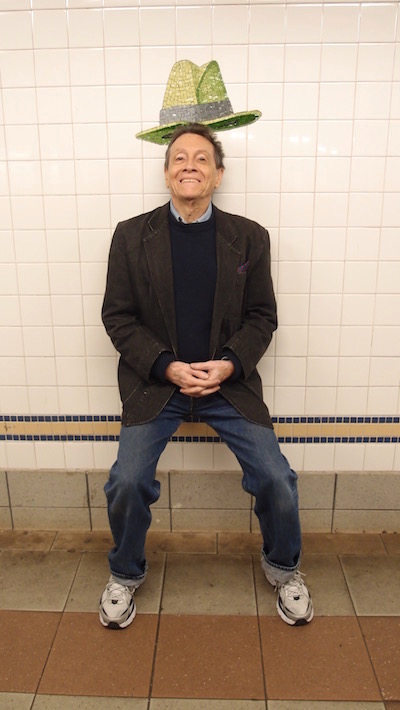
ADC with Sadakichi Hartmann’s hat, New York, May 15, 2015 (a). Photo © 2015 by Anna Lung.
The Metropolitan Transit Authority’s R train local subway station at 23rd St. and Broadway features an installation titled “Memories of Twenty-Third Street,” in which artist Keith Godard pays homage to the famous men and women who a century ago were known to have frequented the area. “From the 1880s through the 1920s, 23rd Street was a major vaudeville, entertainment, and cultural district, and ‘Ladies Mile,’ the fashion and department store haven of the time, was located nearby,” according to the MTA’s Arts for Transit website. Godard’s tribute consists of mosaic inlays of images of the types of hats that his selected cultural figures — Lily Langtry, Sarah Bernhardt, Isadora Duncan, P. T. Barnum, Marie Curie, Winslow Homer, and Hartmann among them — wore in period photos of them.
An appointment in the neighborhood brought my wife Anna and myself to that station just after noon on May 15. So, with a few minutes to spare, we hunted down Hartmann’s hat, which appears at the south end of the uptown platform of the station. Anna proceeded to make portraits of me beside and under the headgear, paying my respects to my predecessor and role model. Godard positioned the mosaics at different heights along the two platforms, so I had to crouch a bit to get under Sadakichi’s fedora.
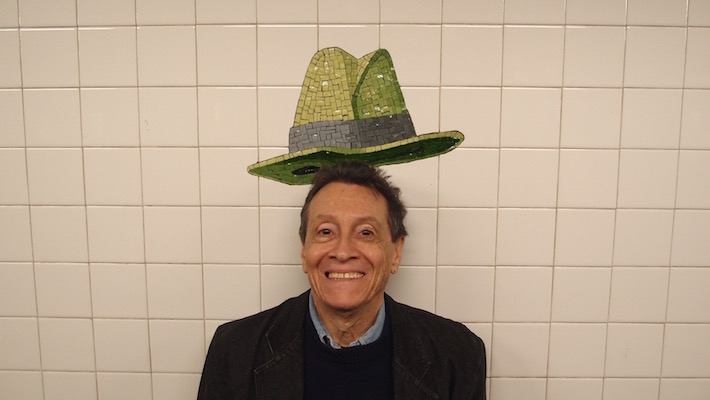
ADC with Sadakichi Hartmann’s hat, New York, May 15, 2015 (c). Photo © 2015 by Anna Lung.
From the Midden Heap
To Anna’s initial embarrassment and consternation but eventual bemusement and toleration, I pick up stuff off the streets — odd scraps of paper, lost earrings, all kinds of discarded ephemera. I don’t know when I started doing that, nor why. It’s just a habit by now, my own odd way of reading my culture from its leavings, finding coded messages in cast-offs, a John Cagean relationship to detritus. I tell myself that someday I’ll do something with it all — I have boxes full by now — but have no immediate plans for it.
Some of what turns up seems highly portentous, even if the message remains obscure. Consider these, found on the sidewalk at the corner of Van Duzer and Court Street here on Staten Island, as I took a walk on the sunny afternoon of May 8:
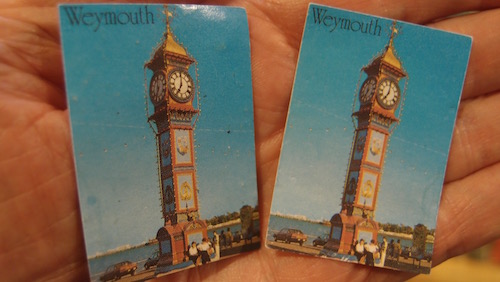
Weymouth Wales tickets (1)
As I examined them, the name “Weymouth” struck me immediately, of course, since it has appeared regularly in my posts at this blog over the past year. A city in Dorset, England, Weymouth served as the jumping-off point for the Allied armada that headed to Normandy for the D-Day invasion, with Robert Capa aboard one of the troopships, en route to his rendezvous with destiny. A bit of online research confirmed that the image shows a Weymouth landmark, the Jubilee Memorial Clock Tower, installed in 1887 to honor Queen Victoria. Overlooking the harbor, this clock would have witnessed that vast flotilla assembling on June 4-5, 1944; Capa and the troops in turn would have seen it as they settled on board and sailed off.
What odds would you give that these images of that small city (pop. 53,000), now mostly a tourist resort, would end up on the pavement a few feet from my front door?

Flying Dragon LLC logo
But it gets weirder. Turning these over, I discovered, to my astonishment, an image of a flying dragon — a creature from Chinese mythology, definitely not British in origin. (The Brits of course had their toehold in China, Hong Kong, from 1842 till 1997.) It’s a representation derived from a Chinese paper cut — Anna and I use a variant thereof as the logo for our registered business, Flying Dragon LLC. What is the likelihood that two pieces of paper containing references to both my current research project and our small enterprise would show up here like that?
Below that, in a large bold font, appears the word “Wales,” the name of one of the countries that comprise the United Kingdom. But Wales has no city named Weymouth. Say what?

Weymouth Wales tickets (2)
Further online research revealed that, inexplicably, the Chinese flying dragon features prominently in the logos of both the Football Association of Wales (which governs traditional soccer in that country) and the Welsh Australian Rules Football League (WARFL). Australian Rules Football, which originated down under, appears to lie somewhere between soccer, rugby, and American-style football, and has become popular in Wales.
However, no Welsh team in either league bears the name “Weymouth Wales.” That is the name of a Barbadian team from the Caribbean that plays traditional soccer. Its logo does not include a flying dragon.
All very strange.
FHRITPA
Speaking of soccer: From the Latin, puer (from which we get puerile; it translates roughly as boychild) and aeternus (which gives us eternal), we derive the useful concept of puer aeternus — perpetual male adolescence. Though I try to avoid amateur psychoanalysis, I can’t resist offering this as the obvious diagnosis for Shawn Simoes, the 30-year-old former “senior financial analyst” and soccer fanboy, now internationally infamous for mansplaining to Canadian TV reporter Shauna Hunt how someone else screaming a misogynistic vulgarity into her microphone for all the world to hear is “fucking hilarious” and he “respect[s] it.”

Shauna Hunt (l), Shawn Simoes (r), Toronto, May 10, 2015, screenshot
Though I try to keep up with the cultural trends, I confess total unawareness of the FHRITP viral meme, and its origin as “a viral hoax campaign orchestrated by Cincinnati-based filmmaker John Cain,” before this story came out (on Mother’s Day, appropriately). I find it effing hilarious to watch this pathetic twerp lose his USD $88,620 job in 77 seconds, due to his total cluelessness about the fact that projecting a visual and auditory mass-media image of himself aggressively justifying a bullying, insulting meme whose hostility to women, immaturity, egocentricity, and fundamental rudeness inevitably affects his professional life and work environment. Fucked himself right in the puer aeternus — and right in the wallet. Effing hilarious, as I said.

FHRITP T-shirt
Hilarious, too, that, given the working of mass media and social media today — something of which we expect millennials like Simoes to have keen awareness — this self-portrait he created on live TV will follow him for the rest of his days. Reeking of narcissistic entitlement, this textbook example of sexual harrassment immediately became the very first thing any prospective employer, and any prospective girlfriend (or boyfriend), will discover about him from an online search henceforth. Mention of it will appear in his obituary — count on it.
Will Simoes learn anything from this experience? I wouldn’t bet on it. More likely, some combination of self-promoting lawyers and aggrieved Men’s Rights Activists will persuade him to file a suit for wrongful termination, which won’t likely get him his job back or anything beyond his severance pay, but will certainly revive the outpouring of scorn and derision he’s experiencing presently. (Click here to enter the parallel universe in which an MRA spokesperson mansplains that a vindictive, unprofessional female TV reporter inappropriately subjected an inebriated Simoes to media rape, and owes him an apology. I kid you not.)
CityNews, the TV station for which the courageous reporter who confronted him works, reported that Simoes sent Hunt a written apology on May 15 (most likely following the advice of counsel). A CBC account elaborates:
“The station quotes Hunt as saying she appreciated him reaching out with what she felt was a ‘very genuine apology’ and was ‘happy to accept it.’
“CityNews reports the man told Hunt he intended the apology to be a personal note to her and she won’t release exactly what was said.”
There, once again, speaks the perpetual adolescent. Because in the adult world, which I suspect Shawn Simoes will never enter, you don’t get to commit a public offense against someone and then make private amends. Fitting, therefore, that he defined himself publicly forever with that pubescent outburst. As for his overnight firing by Hydro One, a public utility company: I respect it. To quote one of the amused bro bystanders to that exchange, Ryan Hart of Cognex (a private manufacturer of machine vision systems), “I feel like it’s quite substantial.” Canada’s “employment insurance” program only covers “individuals who lose their jobs through no fault of their own” — so, having gotten himself fired for cause, Simoes will likely find himself s**t out of luck.
Ends and Odds Encore
Last week I finally got to do something I’ve planned for years: have some pictures made of myself wearing Sadakichi Hartmann’s hat.
That calls for some explanation.
Scion of a German father and a Japanese mother, Sadakichi Hartmann (1867-1944) was born on an island in Nagasaki harbor. His mother died in childbirth, and he and his older brother were taken to Hamburg, Germany, and raised in luxury. By the age of 9 he’d reportedly read all of Goethe and Schiller. At the age of 13 he was placed in military school but rebelled against the discipline there and ran away to Paris. His angry father shipped him off to America to live with an uncle here. He arrived in 1882, found work in printing and engraving shops, and educated himself by reading at night in Philadelphia’s excellent free Mercantile Library.
Charles Fournier, portrait of Sadakichi Hartmann (1917)
Drawn to the arts, Hartmann befriended Walt Whitman, for whom he did occasional translation of German correspondence. He recorded his visits to the aged poet in Conversations with Walt Whitman (1895). He made his way to Europe and the U.K. four times to further his knowledge of theater, literature, and visual art, managing to meet Algernon Charles Swinburne, the Rossettis (Dante Gabriel and his sister Christina), Stéphane Mallarmé, and Franz Liszt, among other notables. (He corresponded with Mallarmé through 1897.)
Hartmann began his work as an art critic for Philadelphia newspapers in the 1880s, and subsidized his travel to Europe in 1891 by going as a foreign correspondent for the McClure Syndicate, as a result of which he interviewed many of the major creative artists and writers of the time. His first commentaries on photography came circa 1893, his last around 1920. During that period, in addition to writing extensively about the medium for a wide range of periodicals, he lectured widely on the subject and juried countless exhibitions of photography across the U.S.
ADC with Sadakichi Hartmann’s hat, New York, May 15, 2015 (b). Photo © 2015 by Anna Lung.
In 1892 he became a staff writer for a Boston publication, and in 1893 founded a short-lived avant-garde art magazine, The Art Critic, which lasted a mere four issues. He then relocated to New York and strode through the streets of Greenwich Village with long, flowing dark hair, wearing a cape — a flamboyant figure, the self-styled “king of Bohemia” (though he called himself “a bread-and-butter writer” because he wrote for a living). He had many talents, many of them not fully realized during his lifetime. Edward Weston, who saw him perform at a party when Hartmann was in his sixties, once described him as the finest interpretive male dancer he’d ever seen, an opinion shared by many.
ADC with Sadakichi Hartmann’s hat, New York, May 15, 2015 (d). Photo © 2015 by Anna Lung.
A poet, playwright, author of short fiction, and graphic artist, as well as a critic of art and photography, Hartmann also published under various pseudonyms, the most frequent of which was Sidney Allan. He began to engage with photography at the moment when Alfred Stieglitz and others commenced their push for its recognition as an art form. Along with Charles Caffin, he became something of a “house critic” for Camera Notes during Stieglitz’s editorship thereof and then for Camera Work, the journal founded by Stieglitz in the early years of the twentieth century.
Hartmann published well over 600 essays on photography during the course of his career, making him unquestionably the most prolific critic of the medium up until that point and for half a century thereafter. According to Harry W. Lawton and George Knox, “He was admired; he was feared; he was detested. Among the pioneers of photographic criticism in America none exerted such direct personal influence on so many photographers” as did Hartmann.
Sadakichi Hartmann’s headstone, St. Petersburg, FL
In 1923, having given up writing on art and photography, Hartmann moved to Hollywood, where he wrote the first film adaptation of Don Quixote (unproduced), played a bit part in The Thief of Baghdad, and hung out with John Barrymore and other luminaries. Toward the end of his life he resided on the Morongo Indian reservation in Banning, California, occupying a one-room shack he constructed himself. Just before his death in 1944 he traveled by bus to St. Petersburg, Florida, to visit one of his daughters, but died a few hours after his arrival there on November 22. So his life overlaps mine by 11 months. (For more on Hartmann, click here.)
ADC with Sadakichi Hartmann’s hat, New York, May 15, 2015 (a). Photo © 2015 by Anna Lung.
The Metropolitan Transit Authority’s R train local subway station at 23rd St. and Broadway features an installation titled “Memories of Twenty-Third Street,” in which artist Keith Godard pays homage to the famous men and women who a century ago were known to have frequented the area. “From the 1880s through the 1920s, 23rd Street was a major vaudeville, entertainment, and cultural district, and ‘Ladies Mile,’ the fashion and department store haven of the time, was located nearby,” according to the MTA’s Arts for Transit website. Godard’s tribute consists of mosaic inlays of images of the types of hats that his selected cultural figures — Lily Langtry, Sarah Bernhardt, Isadora Duncan, P. T. Barnum, Marie Curie, Winslow Homer, and Hartmann among them — wore in period photos of them.
An appointment in the neighborhood brought my wife Anna and myself to that station just after noon on May 15. So, with a few minutes to spare, we hunted down Hartmann’s hat, which appears at the south end of the uptown platform of the station. Anna proceeded to make portraits of me beside and under the headgear, paying my respects to my predecessor and role model. Godard positioned the mosaics at different heights along the two platforms, so I had to crouch a bit to get under Sadakichi’s fedora.
ADC with Sadakichi Hartmann’s hat, New York, May 15, 2015 (c). Photo © 2015 by Anna Lung.
From the Midden Heap
To Anna’s initial embarrassment and consternation but eventual bemusement and toleration, I pick up stuff off the streets — odd scraps of paper, lost earrings, all kinds of discarded ephemera. I don’t know when I started doing that, nor why. It’s just a habit by now, my own odd way of reading my culture from its leavings, finding coded messages in cast-offs, a John Cagean relationship to detritus. I tell myself that someday I’ll do something with it all — I have boxes full by now — but have no immediate plans for it.
Some of what turns up seems highly portentous, even if the message remains obscure. Consider these, found on the sidewalk at the corner of Van Duzer and Court Street here on Staten Island, as I took a walk on the sunny afternoon of May 8:
Weymouth Wales tickets (1)
As I examined them, the name “Weymouth” struck me immediately, of course, since it has appeared regularly in my posts at this blog over the past year. A city in Dorset, England, Weymouth served as the jumping-off point for the Allied armada that headed to Normandy for the D-Day invasion, with Robert Capa aboard one of the troopships, en route to his rendezvous with destiny. A bit of online research confirmed that the image shows a Weymouth landmark, the Jubilee Memorial Clock Tower, installed in 1887 to honor Queen Victoria. Overlooking the harbor, this clock would have witnessed that vast flotilla assembling on June 4-5, 1944; Capa and the troops in turn would have seen it as they settled on board and sailed off.
What odds would you give that these images of that small city (pop. 53,000), now mostly a tourist resort, would end up on the pavement a few feet from my front door?
Flying Dragon LLC logo
But it gets weirder. Turning these over, I discovered, to my astonishment, an image of a flying dragon — a creature from Chinese mythology, definitely not British in origin. (The Brits of course had their toehold in China, Hong Kong, from 1842 till 1997.) It’s a representation derived from a Chinese paper cut — Anna and I use a variant thereof as the logo for our registered business, Flying Dragon LLC. What is the likelihood that two pieces of paper containing references to both my current research project and our small enterprise would show up here like that?
Below that, in a large bold font, appears the word “Wales,” the name of one of the countries that comprise the United Kingdom. But Wales has no city named Weymouth. Say what?
Weymouth Wales tickets (2)
Further online research revealed that, inexplicably, the Chinese flying dragon features prominently in the logos of both the Football Association of Wales (which governs traditional soccer in that country) and the Welsh Australian Rules Football League (WARFL). Australian Rules Football, which originated down under, appears to lie somewhere between soccer, rugby, and American-style football, and has become popular in Wales.
However, no Welsh team in either league bears the name “Weymouth Wales.” That is the name of a Barbadian team from the Caribbean that plays traditional soccer. Its logo does not include a flying dragon.
All very strange.
FHRITPA
Speaking of soccer: From the Latin, puer (from which we get puerile; it translates roughly as boychild) and aeternus (which gives us eternal), we derive the useful concept of puer aeternus — perpetual male adolescence. Though I try to avoid amateur psychoanalysis, I can’t resist offering this as the obvious diagnosis for Shawn Simoes, the 30-year-old former “senior financial analyst” and soccer fanboy, now internationally infamous for mansplaining to Canadian TV reporter Shauna Hunt how someone else screaming a misogynistic vulgarity into her microphone for all the world to hear is “fucking hilarious” and he “respect[s] it.”
Shauna Hunt (l), Shawn Simoes (r), Toronto, May 10, 2015, screenshot
Though I try to keep up with the cultural trends, I confess total unawareness of the FHRITP viral meme, and its origin as “a viral hoax campaign orchestrated by Cincinnati-based filmmaker John Cain,” before this story came out (on Mother’s Day, appropriately). I find it effing hilarious to watch this pathetic twerp lose his USD $88,620 job in 77 seconds, due to his total cluelessness about the fact that projecting a visual and auditory mass-media image of himself aggressively justifying a bullying, insulting meme whose hostility to women, immaturity, egocentricity, and fundamental rudeness inevitably affects his professional life and work environment. Fucked himself right in the puer aeternus — and right in the wallet. Effing hilarious, as I said.
FHRITP T-shirt
Hilarious, too, that, given the working of mass media and social media today — something of which we expect millennials like Simoes to have keen awareness — this self-portrait he created on live TV will follow him for the rest of his days. Reeking of narcissistic entitlement, this textbook example of sexual harrassment immediately became the very first thing any prospective employer, and any prospective girlfriend (or boyfriend), will discover about him from an online search henceforth. Mention of it will appear in his obituary — count on it.
Will Simoes learn anything from this experience? I wouldn’t bet on it. More likely, some combination of self-promoting lawyers and aggrieved Men’s Rights Activists will persuade him to file a suit for wrongful termination, which won’t likely get him his job back or anything beyond his severance pay, but will certainly revive the outpouring of scorn and derision he’s experiencing presently. (Click here to enter the parallel universe in which an MRA spokesperson mansplains that a vindictive, unprofessional female TV reporter inappropriately subjected an inebriated Simoes to media rape, and owes him an apology. I kid you not.)
CityNews, the TV station for which the courageous reporter who confronted him works, reported that Simoes sent Hunt a written apology on May 15 (most likely following the advice of counsel). A CBC account elaborates:
“The station quotes Hunt as saying she appreciated him reaching out with what she felt was a ‘very genuine apology’ and was ‘happy to accept it.’
“CityNews reports the man told Hunt he intended the apology to be a personal note to her and she won’t release exactly what was said.”
There, once again, speaks the perpetual adolescent. Because in the adult world, which I suspect Shawn Simoes will never enter, you don’t get to commit a public offense against someone and then make private amends. Fitting, therefore, that he defined himself publicly forever with that pubescent outburst. As for his overnight firing by Hydro One, a public utility company: I respect it. To quote one of the amused bro bystanders to that exchange, Ryan Hart of Cognex (a private manufacturer of machine vision systems), “I feel like it’s quite substantial.” Canada’s “employment insurance” program only covers “individuals who lose their jobs through no fault of their own” — so, having gotten himself fired for cause, Simoes will likely find himself s**t out of luck.